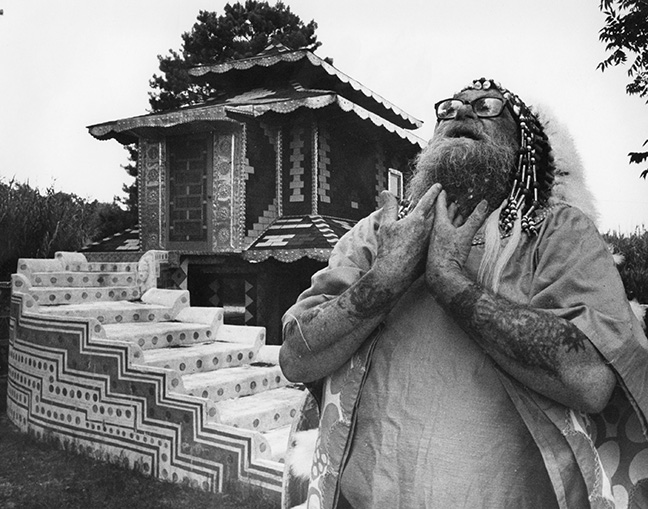Bone towers built in a kitchen. Concrete sculptures constructed in the yard of a lakeshore home. Elaborate fiber hangings woven in a New York City loft. These works suggest the wide-ranging nature of art environments.
Art environments are spaces that have been significantly transformed to embody and express aspects of the artist’s life experience, their surrounding geography, or culture. The works are immersive, typically immobile, and are found around the globe—from Wisconsin’s Northwoods to northern India.
Monumental in scale or number of components (or both), art environments are meant to be experienced as a whole rather than as individual, discrete elements. The secret lies in the relationship between the artist and the place, and in the “conversation” among the site’s multitude of parts.
A single hanging construction from Emery Blagdon’s shed environment known as “The Healing Machine” is a gratifying work to observe. However, when placed within its intended context—surrounded by hundreds of the artist’s other constructions, sculptures, and paintings—a sense of holistic integration emerges.
The reasons behind the creation of an art environment vary widely. Some are created for public viewing with edification or storytelling as goals, others are private spaces where the artist addresses personal issues or seeks inspiration and connection to materiality.
Loy Bowlin created the sparkling Beautiful Holy Jewel Home to reflect his adopted persona as the Original Rhinestone Cowboy. Using rocks and debris from villages razed to build the city of Chandigargh, India, Nek Chand created an expansive kingdom teeming with sculptures of royalty, animals, holy men, musicians, soldiers, and more.
Levi Fisher Ames populated his 19th-century traveling tent-show environment with hundreds of carved figures of animals, Insects, and characters from life, legend, and folklore—vividly evincing his gift for storytelling and entertaining in a grand style. Lenore Tawney’s loft-space art environments, where she lived and worked, were filled with found and created objects that inspired her lifestyle and her artistic practice exploring fiber and other media.
The category spans many artistic practices, and the makers range from academically trained artists to self-taught and vernacular artists. Often there are no formal plans for the environments; they result from an additive, organic process over the course of years.
Unlike installation art, which is also an immersive experience, art environments occur outside traditional institutional or gallery settings. In addition, art environments are typically intended as permanent works that may be modified over time rather than as temporary exhibited works.
The John Michael Kohler Arts Center holds the world’s largest collection of works from art environments. That collection will be available for viewing and study in June 2021 with the opening of the Arts Center’s new building, the Art Preserve.
When an environment enters the collection, the Arts Center recognizes there has been a break between the in-situ environment and the relocated components of that art environment. At the Art Preserve, large bodies of works from an environment are presented together, whenever possible, to evoke the integral qualities of the original site.

















